Last year two DVDs about spin and fly fishing for sea trout in Denmark were released.
Last year two DVDs about spin and fly fishing for sea trout in Denmark were released. New flies, spinning techniques and gear set-ups were parts of the DVDs, but what really struck the Germans, Swedes and Danes, were the underwater recordings, showing big schools of sea trout swimming around following the fly without taking. The DVD's quickly became modern classics.
One of the flies in the DVD's was Pattegrisen (the original name) or The Pink Pig tied by one of the guys behind many articles about fishing on the Danish island Fyn. The originator Claus Eriksen was strongly inspired by Morten Øland's Spey Shrimp when he made this pink/coral version with a few substituted materials - which made it all better.
"I have tied that shrimp in all colors, and all of them catches fish, but the pink-pig-color is superior to all other", Claus explains and continues "In fact, it is so poisonous that even mid summer and early autumn, I get quite a score on that fly in size 4-6. All books and articles (including my own) covering that time of the year all say the same: using small, pathetic flies and long, fine leaders is the only way to go."
"The last two summers with the pig have turned that picture up-side down." he says.
Now Claus nearly always has this fly at the end of his tippet. The smaller fish often release themselves (about 50%) but the bigger ones get hooked and stay on a size 4. He uses it at all times under all conditions, even on bright, sunny days, crystal clear water and with a surface like a mirror.
Boring, sometimes, but the fish love it. Often Claus attaches a small, grey gammarus, size 10-12 some 50 cm/20" up the leader just for the variation, but this smaller fly rarely takes any fish. Well, of course if The Pink Pig is already luring the fish.
If The Pink Pig leaves the tippet for a more natural colored fly or maybe a Magnus or likewise, then the small gammarus is back on the top taking quite a part of the fish.
"If that's not convincing..." as Claus puts it.
It is not only the Scandinavian sea trout, which is interested. The fly has become an angler's favorite, and under a warm breeze in Mexico it was attacked by 4 big scaled tarpons - after nearly all tarpon classics had been thrown into the ocean in vain. But as you may already know, four takes from a tarpon does not even bring that bony mouth fish close to a camera lens.
Great fishermen never die; they just smell that way - if you also want to smell a bit of fish - and pig - you may want to take a look at the following step-by-step guide.
- Log in to post comments





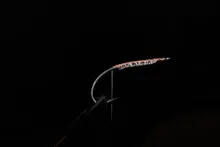

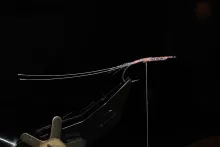
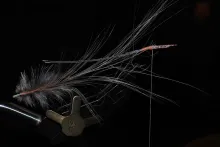
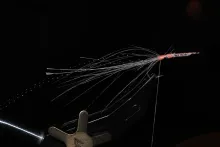
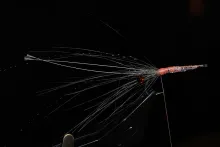
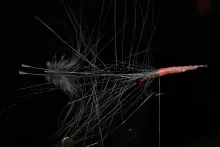
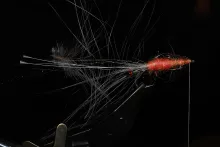
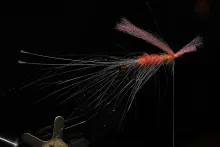

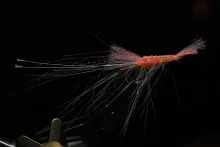


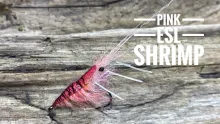
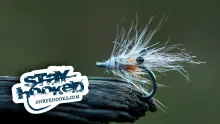


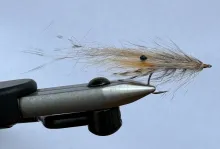

A friend of mine
A friend of mine has replaced Spey feathers with his dog fur. He uses long hair from his honey-brown hovawart as shrimp's legs and underfur dubbing for shrimp's body. The fly looks very good and caught a lot of fish.
In my opinion shrimp made from dog fur is much durable than shrimp made from Spey feathers.
I prefer Spey feathers because my friend doesn't want to dye his dog to pink colour :-)))
Very nice looking
Very nice looking shrimp fly!
What kind of spey hackle is used? I'm not familiar with tying Spey flies and the hackles used for this pattern look much nicer then the Shlappen feathers I have tried. Looking to order something different but not sure what. Thank you for any input!
Waldron
Denis,
Kasper is using a Waldron vice made by British Lawrence Waldron. You can get a factory made vice of his design from Snowbee. Not the same as the hand built one, but quite fine.
Martin
What vice
Hi i was wondering what kind of vice the tyer is using. From the pictures its seems to be a quite practical one..
Seems to work
Igmar,
that seems to work. The originator of the fly, Claus Eriksen, has also tied some with foam for tricky rainbows in shallow water. I will add a photo later.
It would be great to see some photos of your sea bass/trout in the forum as well as your variants of Pattegrisen . Keep us posted!
Kasper
I did it like you told
Kasper,
I did it like you told me to and it worked very well. The "original Oland "pattern turned about 50% of the time up side down. Your way worked much better, now the fly was about 80% of the time in the right position (not up side down). But being an perfectionist, I wanted to have it 100% of the time in the right position. The solution is very simple, The only thing I have changed in your pattern was replacing the antron back for a "salmon coloured" foam back. Cut like in the shape like Oland does. Because of the weighting the fly will sink rapid, but the foam back give enough pressure to keep the back on top. And the hookpoint will just slightly touch the bottom if given time to sink down all the way. It is so deadly, in the Netherlands the trout of the Oostvoornse Meer like them very much (even when there are at this moment no shrimps left in the lake). In mid April I will throw the improved shrimp in the Baltic. With all confidence.
Thank you for this wonderfull pattern! It has become my favorite!
Hey Kasper
Hey Kasper,
Paul and me were out for seatrouts last weekend and Paul had great success with you pink piggy.
He gave one to me out of his stockpile but it couldn't get me a fish this time, so I had to return to my
terror fly.
Hope we hear from each other soon.
Kai
Fantastic
Fantastic, really good imitation.
Combination
Igmar,
The combination of tungsten under the shank and antron over the shank is the way to go. Besides the small tuft at the eye may make the fly rotate as well, so try cutting that off.
Thanks for your comment.
Kasper
The bomb!
Dear Kasper (& Claus),
This pattern is the bomb! Last year I fished the pink/coral Oland shrimp (after the Danish Seatrout Meeting at Kolding) and it was a real succes. The only problem was that the shrimp sometimes turned upside down (and I fixed the weight properly under the hookshank). Can I see this one as an evolution of the Oland Shrimp? I am trying to fix that turning problem, so maybe adding Antron is the solution? Because in the film the fly isn't turning upside down at all.
I am also experimenting with a small foam section in it, for seabass in The Netherlands (fished with heavy sinking flylines).
Great story, Great Fly (just like the Honey Shrimp)!!